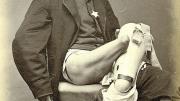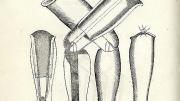Americans can’t seem to get their Civil War out of their heads. It was bloodshed on home ground, and it was hugely bloody, with 620,000 killed in action or dead of wounds or disease. Last December, the Center for the History of Medicine held a program to mark the one-hundred-fiftieth anniversary of the war. Drew Faust, Lincoln professor of history and president of Harvard, spoke on “Civil War and the End of Life.” Jeffrey Reznick, of the National Library of Medicine, spoke on “Disability and the Cultural History of Modern War.” (A video may be seen at https://cms.www.countway.harvard.edu/wp/?p=6531.)
A current exhibition at the Countway Library of Medicine, Battle-Scarred: Caring for the Sick and Wounded of the Civil War, examines the American Civil War from a particular perspective, to commemorate those who died in battle and also document the experience of the wounded and the ill and the men and women who cared for them on the battlefield, in hospitals and prison camps, and on the home front. The exhibition was curated by Jack Eckert and Dominic Hall; an online version created by Jennifer Hornsby appears on the website above.
This lithographic bird’s-eye view from the exhibition of the Satterlee U.S.A. General Hospital in West Philadelphia, done by Charles Magnus in 1864, with the numerous hospital buildings surrounded by a village of tents, gives a notion of the scale of the medical and human problems faced.
All wars lead to advances in the treatment of trauma, and much was learned about amputations and artificial limbs from the Civil War carnage. Charles T. Greene, above, had his leg amputated at the knee after the lower part was carried away by a cannon ball. The photograph, by William Bell, circa 1864, was one of many examples of surgical cases and specimens published by the Surgeon General’s office for the edification of the medical profession.
The many amputations fostered an industry in artificial limbs. The Salem Leg Company had an early lead due to a recommendation by the government. But there was competition. Darwin DeForrest Douglass marketed an artificial leg that he claimed to be far superior to “those cheap ephemeral substitutes known as ‘government legs.’” But consider this testimonial for Salem legs from a soldier: “I work 10 hours every day, and have to stand all the time. Besides that, I walk to and from my meals three times a day, and that is about three miles. As to dancing, I have tried to three times; but as my leg had not been to school, I could not do it very well, but expect to before winter is over.”











